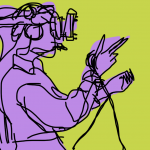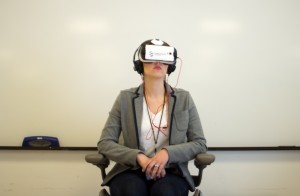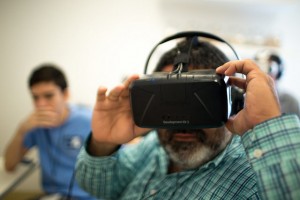
The feeling that people are out to get you is one of the most dramatic mental health symptoms. Current treatments are far from perfect.
The study by Daniel Freeman and colleagues published yesterday in the British Journal of Psychiatry looks at using virtual reality to reduce persecutory delusions. I am a medical student in Oxford where the majority of the authors of this research work (*conflict of interest alert*).
Delusions are false, unshakeable ideas or beliefs, held with subjective certainty (Sims 2003). They are often bizarre and become central in the person’s life. Someone experiencing a delusion cannot be convinced that their belief is incorrect; even if there is evidence showing that it is false. Persecutory delusions involve thinking, without proof, that people are trying to harm you.
Freeman and colleagues suggest one reason why people continue to believe their delusions is that they engage in safety behaviours (things that make them feel safe) which prevent them from discovering and processing evidence that disproves their beliefs.
Virtual reality may offer a way to challenge unfounded beliefs by exposing people to evidence that disproves their delusions and encourages them to stop their safety behaviours.

Virtual reality may help people disprove their delusions and encourage safety behaviours to dissipate.
Methods
30 patients were recruited from adult mental health services in Oxford Health NHS Foundation Trust. To be eligible to participate they had to:
- Have a current persecutory delusion, defined by this study group as “an unfounded belief that harm is occurring, or is going to occur, to him or her and that the persecutor has the intention to cause harm” (Freeman & Garety 2000).
- The delusion held with at least 50% conviction
- A case-note diagnosis of non-affective psychosis (so not a psychosis with a prominent mood element)
- Reporting feeling threatened when around other people
- Using safety behaviours.
People were excluded from taking part in the study if they had:
- A primary diagnosis of alcohol or substance dependency
- An organic cause of mental health symptoms or learning disability
- Photosensitive epilepsy
- Inadequate command of spoken English to engage in the study.
A few days before the experiment, participants completed some baseline questionnaires to measure symptoms of psychosis (Positive and Negative Syndrome Scale – positive scale; Psychotic Symptoms Rating Scale), anxiety (Beck Anxiety Inventory), depression (Beck Depression Inventory), and the use of safety behaviours (Safety Behaviours Questionnaire – Persecutory Beliefs).
Participants rated the conviction of their persecutory delusion from 0% (do not believe at all) to 100% (absolutely certain). They completed a 5 minute behavioural test that involved entering a social environment that they wanted to be less fearful in (e.g. walking to the local shop).
Then participants went to the virtual reality lab and were randomised using an online randomisation generator to either undergo virtual reality cognitive therapy (‘Threat belief testing group’) or virtual reality alone (‘Exposure group’). Both groups experienced the virtual reality environments, but the difference between the groups is that the threat belief testing group were encouraged to drop their safety behaviours as a test of their threat beliefs, while the exposure group were not.
The participants had 7 brief periods in virtual reality in 2 different scenarios; an underground train ride and a lift. The scenarios got more challenging by including more people (avatars) in them. The train carriage scenario progressed from no avatars to 22 avatars, and the lift scenario progressed from 2 avatars to 6. Before and after each virtual reality exposure, participants were asked ‘At this moment how convinced are you that your worries are true?’ (to measure delusion conviction) and ‘How distressed do you feel about your worries?’ (to measure distress). The amount that the participants moved about in the carriage scenarios was also measured.
Finally, participants repeated the behavioural test and rated the conviction of their persecutory delusion.

This small and innovative study set out to prepare the way for future work.
Results
There were 15 people in each group, and the groups were generally similar at the start of the experiment. The mean age was around 40, most participants were of white ethnicity, unemployed, had high levels of depression and anxiety, and had a diagnosis of schizophrenia. However, the gender split was different in the two groups, with 10 males and 5 females in the threat belief testing group and 6 males and 9 females in the exposure group.
- There was a significant reduction in the delusion conviction from the beginning of the experiment to the end of the experiment:
- in the threat belief testing group (79.8% to 46.5%)
- compared to the exposure group (78.5% to 67.6%).
- There was a significant difference between the two groups in the reduction in delusion distress:
- with a reduction from 61.6% to 40.1% in the threat belief testing group
- and a smaller change in the exposure group from 67.9% to 57.7%.
- In terms of movement in the virtual reality world, there was a significant difference between the 2 groups in the final carriage scenario, the threat belief testing group moving an additional 10.5 metres compared to the exposure group.
- When they repeated the real world behavioural test after the virtual reality experience, the threat belief group found the real world task significantly less distressing than the exposure group and had significantly lower delusion conviction.
- Importantly, after the virtual reality experience, there was a significant reduction in the distress that the individuals felt in the threat belief testing group about being outside in the world compared to the exposure group.

These preliminary results suggest that cognitive therapy using virtual reality could help treat delusions, but more work is needed before this treatment could be made more widely available.
Conclusions
The authors concluded:
Virtual reality can be used to present computerised versions of commonly feared situations to patients with persecutory delusions; that new learning can then take place; and, importantly, that the learning transfers to the real world.
Encouraging participants to drop their safety behaviours was more effective than virtual reality exposure alone.
Strengths and limitations
This study uses a novel technique (virtual reality) to challenge persecutory thoughts by providing counter-evidence to a group of participants who may find it hard to engage with traditional forms of cognitive therapy. The use of a behavioural test means we can see that the virtual reality experience also had an impact on reactions in the real world.
The definition of delusions used in this study doesn’t include the requirement that the belief is unshakable/fixed and this may mean that this sample includes people who wouldn’t normally be defined as having a delusion. Instead, participants might have overvalued ideas (which do not need to be firmly held), or anxious or depressive thoughts of a persecutory nature. I would like to see this research repeated with people who have ideas that meet the more classical definition of delusion.
The study has a small number of participants (30 overall) and no placebo control, so we don’t know what happens to delusion conviction and distress if you don’t take part in virtual reality. It would be useful to include a cognitive behavioural therapy condition, as this is the current psychological treatment recommended for people with psychosis and schizophrenia (the dominant diagnosis of participants in this study) (NICE 2014).
Summary
Virtual reality offers a novel way of providing evidence that counters persecutory ideas and creates an environment to try out not using safety behaviours. It is early days in terms of thinking about rolling out virtual reality therapy. More research is needed with a larger sample and should include longer-term follow-up, an assessment of the acceptability of this therapeutic tool for patients, and cost effectiveness analysis.

Could virtual reality facilities play a central role in mental health clinics and wards of the future?
Links
Primary paper
Freeman D, Bradley J, Antley A. et al (2016) Virtual reality in the treatment of persecutory delusions: randomised controlled experimental study testing how to reduce delusional conviction. British Journal of Psychiatry 2016 1-6 doi: 10.1192/bjp.bp.115.176438.
Other references
American Psychiatric Association. (2013). Diagnostic and statistical manual of mental disorders (5th ed.). Arlington, VA: American Psychiatric Publishing.
Freeman D, Garety PA. (2000) Comments on the content of persecutory delusions: does the definition need clarification? Br J Clin Psychol 2000; 39: 407–14. [PubMed abstract]
NICE (2014) Psychosis and schizophrenia in adults: prevention and management CG178. https://www.nice.org.uk/guidance/cg178
Sims A. (2003). Symptoms in the mind: An introduction to descriptive psychopathology. London: Elsevier.

Virtual reality as a treatment for persecutory delusions https://t.co/CynGCO03wy #MentalHealth https://t.co/oIgmt9TU8M
Virtual reality as a treatment for persecutory delusions https://t.co/9hX9IK5T0i
RT @Mental_Elf: Virtual reality as a treatment for persecutory delusions https://t.co/Res1GQ7sCn
Today @Suzanne_Dash on RCT of #VirtualReality for ppl w schizophrenia who experience persecutory delusions https://t.co/Res1GQ7sCn
Hi @ProfDFreeman We’ve blogged about your new paper on virtual reality in treatment of persecutory delusions https://t.co/Res1GQ7sCn
#VirtualReality as a treatment for persecutory #delusions https://t.co/Y5EK5cyUzu @Mental_Elf looks at the #evidence
Could virtual reality facilities play a central role in mental health clinics & wards of the future? https://t.co/Res1GQ7sCn
Virtual reality cognitive therapy may help people disprove their persecutory delusions https://t.co/pppgEkTVYJ https://t.co/6Rryb5Wx9f
New small RCT shows that virtual reality may help ppl w schizophrenia to overcome severe paranoia https://t.co/Res1GQ7sCn
Don’t miss: Virtual reality as a treatment for persecutory delusions https://t.co/Res1GQ7sCn #EBP
Virtual reality as a treatment for persecutory delusions https://t.co/ihRaoPUWKB via @sharethis
[…] 1Virtual reality as a treatment for persecutory delusions- Mental Elf Blog post. […]
[…] research was published in the British Journal of Psychiatry. The Mental Elf produced a review of the research the day after the BBC article […]
[…] Daniel Freeman and colleagues from Oxford University have also been using VR to treat persecutory delusions. A study conducted by his team was recently published in the British Journal of Psychiatry, and covered in a Mental Elf blog by Suzanne Dash: Virtual reality as a treatment for persecutory delusions. […]
[…] Virtual reality as a treatment for persecutory delusions […]
It was very good research
I have one patient in India and he is suffering from persecutory delusion disorder from last 30 year
can you help me in india
[…] Previous Elf blogs have covered research looking at how effective it might be in the treatment of persecutory delusions, paranoia in those living with psychosis, and social anxiety […]